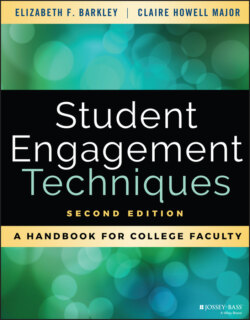Читать книгу Student Engagement Techniques - Elizabeth F. Barkley - Страница 43
Transfer
ОглавлениеWhen activating prior learning to make sense of something new, the brain searches for any past learnings that are similar to, or associated with, the new learning. If the experiences exist, the corresponding neuronal networks or schema are activated, reinforcing the already-stored information as well as assisting in interpreting and assigning meaning to the new information. Svinicki (2004) notes that there are many types of transfer discussed in the literature, but two types are the most important for purposes of instruction (p. 99). The first is positive versus negative transfer. If the connections are accurate, the search results in “positive” transfer that can aid the learner in understanding and integrating new learnings. If, on the other hand, the connections are incorrect, the result is negative transfer, which creates confusion and errors. For example, when teaching Romance languages to English speakers, teachers frequently encounter positive transfer (e.g., “mucho” in Spanish sounds similar to “much” in English) and negative transfer (“librairie” in French sounds like “library,” but means “bookstore”) (Sousa, 2006, pp. 138–139).
The second type of transfer is near versus far transfer. This distinction refers to the type of task: near transfer tasks are those that look very much alike and follow the same rules for responding, while a far transfer task is where the same rules apply, but they are transferred to a different setting. “Far transfer” requires more thinking on the part of the learner. Svinicki (2004) offers driving a midsize automatic sedan as an example: if you've driven one, you can easily drive any other because the steering wheel, gear shift, windshield wipers, and turn signals all look alike and are in the same position. If, on the other hand, you get into a car that is very different (such as a convertible, stick-shift sports car), your normal driving responses are not instantly triggered and you have to stop and figure out where everything is. The rules are the same, but the car looks different. Moving between different midsize automatic sedans is a near transfer task; moving from a mid-level automatic sedan to a stick-shift sports car is a far transfer task (Svinicki, 2004, pp. 100–101). There are several factors that affect the quality of transfer: similarity/difference, association, and context and degree of original learning.
